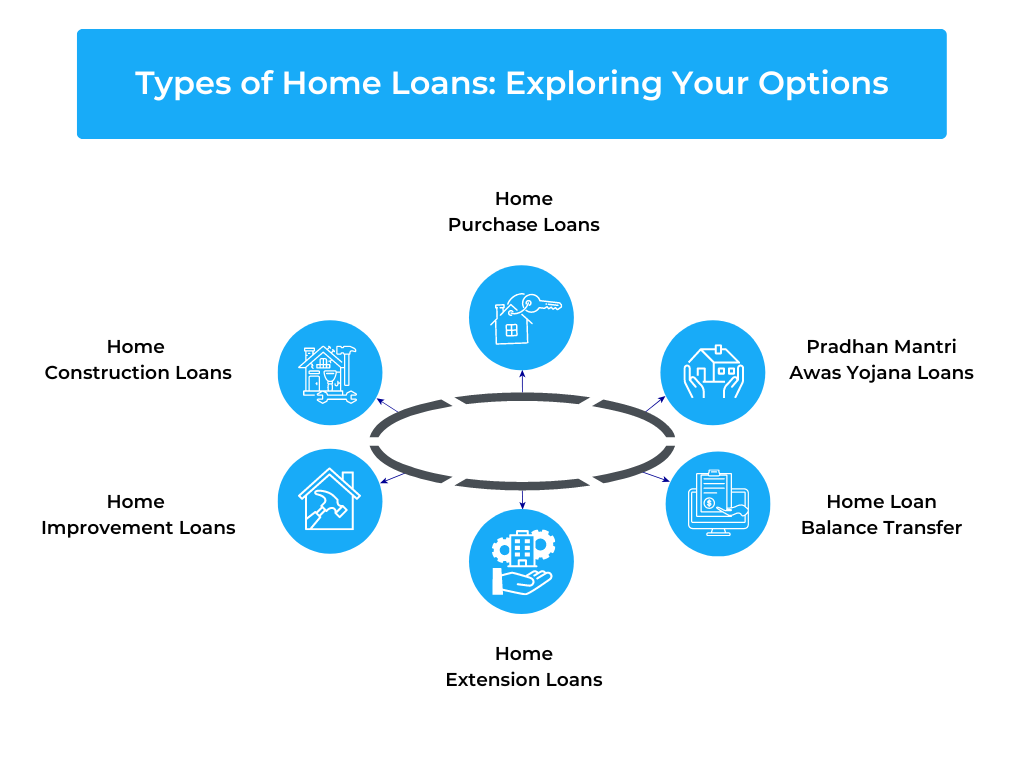Everything You Need To Know Before Taking a Home Loan

Understanding Home Loans: A Comprehensive Overview
A home loan, also known as a mortgage, is a financial product designed to help individuals or families purchase a property. It is a long-term loan provided by financial institutions, such as banks or mortgage lenders, and is secured by the property being purchased. Understanding the key aspects of home loans is crucial for anyone considering homeownership.
Firstly, home loans consist of two main components: the principal amount borrowed and the interest charged on that amount. The principal amount is the total loan value, while the interest is the cost charged by the lender for borrowing the money. Home loans are typically repaid in monthly installments over an extended period, often spanning several years or decades.
Secondly, home loans come with different types of interest rates, such as fixed or variable rates. A fixed-rate home loan offers a stable interest rate throughout the loan term, providing certainty and predictable repayments. On the other hand, a variable-rate home loan has an interest rate that can fluctuate based on market conditions, potentially resulting in varying monthly repayments.
Lastly, home loans require a down payment or a deposit. This is a percentage of the property’s purchase price that the borrower needs to contribute upfront. The down payment, along with other factors like the borrower’s income, credit history, and employment stability, determines the loan amount and the borrower’s eligibility for the loan.
Types of Home Loans: Exploring Your Options

There are several types of home loans available to cater to the diverse needs of prospective homebuyers. Understanding these options can help borrowers make informed decisions based on their specific requirements. Here are some common types of home loans in India:
- Home Purchase Loans: This is the most common type of home loan, aimed at individuals or families looking to purchase a residential property. These loans typically require a down payment and offer flexible repayment options based on the borrower’s income and creditworthiness.
- Home Construction Loans: For individuals planning to build a house on a plot of land they already own, home construction loans are available. These loans provide funds in stages as the construction progresses, helping borrowers manage their finances effectively during the building process.
- Home Improvement Loans: Also known as home renovation loans, these loans are designed to finance renovation or repair work for an existing residential property. Whether it’s upgrading the kitchen, adding an extra room, or enhancing the overall aesthetics, home improvement loans provide funds specifically for these purposes.
- Home Extension Loans: When homeowners wish to extend their current property, such as adding an extra floor or expanding the living space, home extension loans can be availed. These loans help borrowers meet the expenses associated with extending their existing residential property.
- Home Loan Balance Transfer: This option allows borrowers to transfer their existing home loan from one lender to another to benefit from better interest rates or more favorable terms. Home loan balance transfer can potentially lower the monthly installments or reduce the overall interest burden, saving the borrower money in the long run.
- Pradhan Mantri Awas Yojana (PMAY) Loans: The Indian government’s flagship housing scheme, PMAY, offers subsidized home loans for individuals belonging to economically weaker sections (EWS), low-income groups (LIG), and middle-income groups (MIG). These loans come with attractive interest rates and extended repayment periods, making homeownership more affordable for eligible beneficiaries.
Eligibility Criteria and Documentation: What You Need to Qualify
When applying for a home loan, meeting the eligibility criteria and providing the necessary documentation is essential. Lenders have specific requirements to assess an applicant’s creditworthiness and ability to repay the loan. Understanding these criteria and preparing the required documentation in advance can streamline the loan application process. Here are the key factors to consider:
- Income and Employment Stability: Lenders typically evaluate the borrower’s income to determine their loan eligibility. A steady income source, such as employment or business income, is crucial. Salaried individuals may need to provide salary slips, income tax returns, and employment letters. Self-employed individuals may need to submit profit and loss statements, balance sheets, and income tax returns.
- Credit Score and History: Lenders consider the applicant’s credit score and credit history to assess their creditworthiness. A higher credit score improves the chances of loan approval. It is important to maintain a good credit score by paying bills on time, avoiding excessive debt, and regularly checking the credit report for any discrepancies.
- Down Payment: Most lenders require borrowers to contribute a certain percentage of the property’s purchase price as a down payment. The down payment amount varies based on factors like the loan type, loan amount, and the lender’s policy. It is crucial to save for the down payment in advance to meet the lender’s requirements.
- Property Documents: The property being purchased serves as collateral for the loan. Lenders typically require documents such as the sale agreement, title deeds, property valuation reports, and no-objection certificates (NOCs) from relevant authorities. These documents establish the ownership and legal status of the property.
- Age and Residency: Borrowers must meet the minimum age requirement specified by the lender. In India, most lenders have a minimum age of 21 years for salaried individuals and 18 years for self-employed individuals. Additionally, lenders often require borrowers to be Indian citizens or Non-Resident Indians (NRIs) with specific eligibility criteria for NRIs.
- Other Financial Obligations: Lenders consider the borrower’s existing financial commitments, such as ongoing loans or credit card debts, as it affects their repayment capacity. Providing details of any existing loans or financial obligations is necessary during the loan application process.
Interest Rates and Repayment Options: Making Informed Financial Decisions
Interest rates and repayment options play a significant role in determining the cost and affordability of a home loan. Understanding these aspects is crucial for borrowers to make informed financial decisions when choosing a home loan.
Interest rates can either be fixed or floating. Fixed interest rates remain constant throughout the loan tenure, providing predictability and stability in monthly repayments. On the other hand, floating interest rates fluctuate based on market conditions, which can result in varying monthly repayments. Borrowers should carefully consider their risk tolerance, budget, and expectations regarding interest rate stability before deciding between fixed or floating rates. It is also important to compare interest rates offered by different lenders to ensure obtaining the most competitive rate possible.
Repayment options for home loans typically include equated monthly installments (EMIs). EMIs consist of principal and interest components, spread over the loan tenure. Borrowers can choose the loan tenure based on their repayment capacity and financial goals. Opting for a longer tenure may result in lower EMIs but higher overall interest paid, while a shorter tenure may lead to higher EMIs but reduced interest burden. Additionally, some lenders offer flexible repayment options, such as step-up EMIs (gradually increasing EMIs over time), step-down EMIs (gradually decreasing EMIs), or a combination of both, allowing borrowers to align repayments with their financial circumstances and future prospects.
Loan Application Process: Step-by-Step Guide
- Research and Comparison: Begin by researching different lenders and their loan offerings. Compare interest rates, repayment terms, eligibility criteria, and customer reviews to select a suitable lender.
- Gather Documentation: Prepare the necessary documents, such as income proof, identity proof, address proof, bank statements, and property documents, as required by the lender.
- Complete the Application Form: Fill out the loan application form provided by the lender, providing accurate and complete information about your personal and financial details.
- Submit the Application: Submit the completed application form along with the required documents to the lender. Ensure that all the documents are organized and properly arranged.
- Verification and Evaluation: The lender will review your application and documents. They may conduct a credit check, verify the property details, and assess your repayment capacity based on your income and financial standing.
- Loan Approval and Disbursement: If the lender approves your loan application, you will receive an offer letter specifying the loan amount, interest rate, repayment terms, and other conditions. Upon acceptance, the lender will disburse the loan amount to the seller or builder as per the agreed terms.
Potential Challenges and Risks: Considerations Before Committing
- Financial Burden: Taking on a home loan means committing to regular repayments over a long period. It is essential to assess your financial capacity and ensure that the loan installment fits comfortably within your budget to avoid financial strain.
- Interest Rate Fluctuations: If you opt for a floating interest rate, keep in mind that the interest rate can vary over time. Fluctuations in interest rates can impact your monthly installments and overall interest payments, potentially affecting your financial planning.
- Property Value: Real estate markets can be unpredictable, and property values may fluctuate. There is a risk that the value of your property could decrease, which may affect your equity or potential selling value in the future.
- Prepayment Penalties: Some loan agreements impose penalties for prepaying the loan or making early repayments. If you plan to repay the loan before the agreed-upon tenure, consider the prepayment penalties and factor them into your financial calculations.
- Changing Circumstances: Life circumstances can change unexpectedly, such as job loss or health issues, impacting your ability to repay the loan. Assess your financial stability and have contingency plans in place to manage any potential challenges.
- Legal and Documentation Risks: Ensure that all property-related documents are legally sound and free from any legal disputes or encumbrances. Engage legal professionals to thoroughly examine the property documents and ensure a smooth and risk-free transaction.
Conclusion
In conclusion, obtaining a home loan is a significant financial decision that requires careful consideration. By understanding the different types of home loans, eligibility criteria, interest rates, repayment options, and potential challenges, borrowers can navigate the loan application process with confidence. It is crucial to conduct thorough research, compare offerings from multiple lenders, and seek professional advice when needed. With proper planning and informed decision-making, borrowers can secure a home loan that best suits their needs and embark on their homeownership journey with confidence.